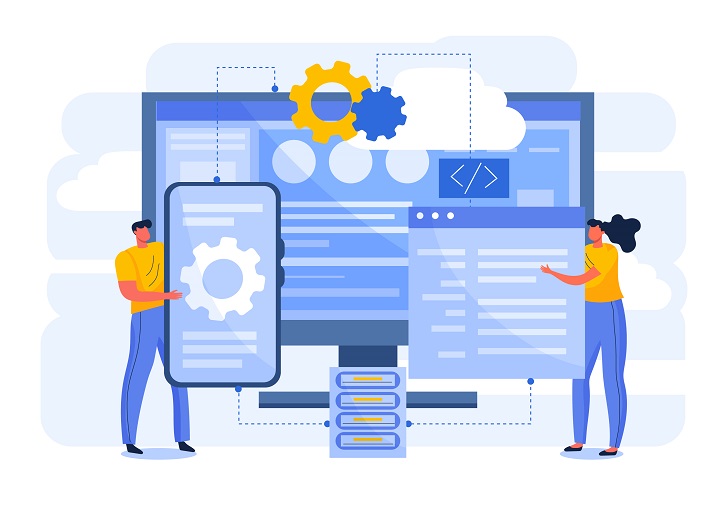The SaaS (Software-as-a-Service) market is expanding rapidly. By 2030, it is projected to reach $909 billion, with an annual growth rate increasing from 18% to 18.9%.
More and more companies are adopting the SaaS model due to its cost-efficiency, scalability, and enhanced security. If you’re interested in how to build a SaaS product, this guide will walk you through the process.
We’ll cover:
- Advantages of SaaS over traditional applications
- Various types of SaaS products
- Steps to creating a reliable SaaS product
- Other crucial considerations like technology stack, development team, and cost estimation
Let’s start by understanding the SaaS model.
Table of Contents:
1. What is a SaaS Product?
2. Benefits of SaaS Development
3. Types of SaaS Applications
4. How to Build a SaaS Product: Main Steps
5. SaaS Application Development at Etelligens
6. Conclusion: How to Develop a SaaS Application

What is a SaaS Product?
SaaS (Software as a Service) is a software delivery model where applications are hosted on the Internet rather than on internal company servers. Users typically access the SaaS product via a web browser or a dedicated app, usually through a subscription.
SaaS offers several advantages over traditional on-premise software, including access from any internet-enabled device, eliminating the need for installations. Businesses benefit from lower IT costs, simplified updates, and continuous service availability.
Benefits of SaaS Development
- Recurring Income: The subscription model provides a steady revenue stream, making it easier to plan for growth.
- Lower Initial Costs: SaaS eliminates the need for costly IT infrastructure investments, making it easier for customers to adopt.
- Scalability: SaaS can grow with your user base without significant infrastructure upgrades.
- Global Reach: SaaS is accessible anywhere with internet access, allowing businesses to expand their customer base.
- Automatic Updates: Providers can roll out updates across all users simultaneously, ensuring your product is always current.
- Security: Centralized hosting reduces piracy risks, and regular updates enhance security.
Types of SaaS Applications
Understanding the types of SaaS products will help you build one that resonates with your audience:
- CRM (Customer Relationship Management): These tools help businesses improve customer connections. Hubspot is a well-known example.
- CMS (Content Management System): Platforms like WordPress.com allow content creation and publishing.
- ERP (Enterprise Resource Planning): Complex systems like Oracle Netsuite help large enterprises manage operations.
- Accounting Solutions: Zoho and similar platforms simplify financial processes.
- Project Management: Tools like Trello and Jira streamline task management.
- Vertical SaaS: Specialized tools for industries like healthcare or insurance, such as Veeva or Guidewire.
- E-commerce: Platforms like Shopify manage online sales, inventory, and more.
- Marketing Tools: Software like Google Analytics and HootSuite assist with marketing strategy.
- Remote Collaboration Tools: Google Drive and Slack enable team collaboration across distances.
How to Build a SaaS Product: Main Steps
To build a successful SaaS product, follow these steps:
Step 1: Confirm Your Idea’s Viability
Validate your idea by researching the market, identifying the target audience, and evaluating existing products. This ensures your product solves a real problem and has market potential.
Step 2: Select Features for Your SaaS Product
Conduct a competitive analysis to prioritize the features users want. Essential features include user authentication, data security, intuitive UI, and customer support.
Step 3: Choose a Monetization Model
Popular pricing models include:
- Per-user Pricing: Common in team-based tools like CRMs.
- Tiered Pricing: Offers different packages for multiple buyer personas.
- Pay-as-you-go: Charges based on usage frequency.
- Subscription: Fixed price for a set product.
- Freemium: Basic functionality is free, with paid upgrades.
Step 4: Choose the Right Technology Stack
Select a tech stack that supports growth. For backend, tools like Node.js or Django are common, while React.js or Vue.js are ideal for frontend development. AWS is a popular choice for cloud hosting.
Step 5: Create a Product Roadmap
Outline the project scope, define key milestones like MVP development, and estimate timeframes for each stage. Plan beyond MVP to accommodate future updates.
Step 6: Develop a Business Plan
A solid business plan includes market research, product description, marketing strategy, financial projections, and team roles. This helps secure funding and guides decision-making.
Step 7: Build Your SaaS Development Team
You have three options for assembling your team:
- Freelancers: Cost-effective but may vary in quality.
- In-house Team: Gives full control but can be expensive.
- Outsourcing: Provides a dedicated team of specialists at a lower operational cost.
Step 8: Build Your SaaS Product
The development process includes a discovery session, UI/UX design, coding, quality assurance, and deployment. Post-launch, monitor performance, gather user feedback, and continue improving the product.
SaaS Application Development at Etelligens
Etelligens has developed SaaS solutions like Kinderlime and SwiftComply, which became leading platforms in their respective industries. Our expertise ensures scalable, high-performance cloud solutions.
Challenges in SaaS Application Development
SaaS development can face hurdles like data protection, integration issues, and downtime during updates. Effective planning and proper infrastructure can mitigate these risks.
Cost of Building a SaaS Solution
Costs vary based on scope, technology, and team rates. For a rough estimate, consider development costs, ongoing maintenance, and marketing expenses. Development for a basic project management platform might range from $111,000 to $396,000.
Conclusion: How to Develop a SaaS Application
The SaaS model offers recurring revenue, scalability, and security benefits. To build a SaaS product:
- Validate your idea.
- Prioritize features.
- Choose the right monetization model.
- Select a scalable technology stack.
- Develop a business roadmap.
Looking for a reliable SaaS development team? Contact Etelligens to turn your vision into reality.